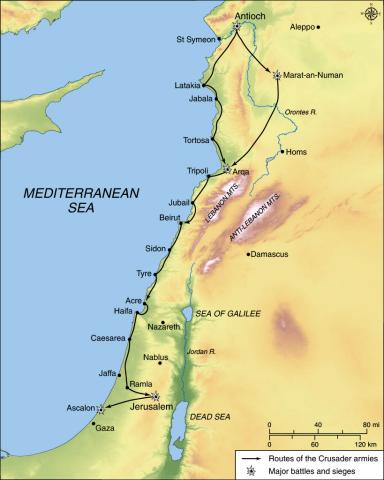The Road to Antioch
[10.34.4] Exeuntēs vērō inde, pervēnimus ad quandam cīvitātem pulcherrimam et omnibus bonīs refertam, in quādam valle sitam, nōmine Kephaliam. Habitātōrēs vērō illīus, audientēs Francōs vēnisse, dīmīsērunt urbem, et hortōs plēnōs oleribus, et domōs plēnās alimentīs corporālibus, et fūgērunt. Tertiā diē ēgressī ab illā urbe, trānsīvimus per altam et immēnsam montaneam, et intrāvimus in vallem dē Sem; in quā erat maxima ūbertās omnibus bonīs; fuimusque ibi per diēs ferē quīndecim. Hīc prope nōs erat quoddam castrum, in quō erat congregāta maxima pāgānōrum multitūdō. Quod castrum aggressī sunt nostrī, idque fortiter superāssent, nisi Saracēnī iactāssent forās immēnsās turmās animālium. Reversī sunt nostrī, dēferentēs omnia bona ad sua tentōria.
notes
(January–February 1099) The crusaders march to a place called Kephalia, whose inhabitants flee at their approach, leaving large stores of food behind. The crusaders proceed to another castle, whose inhabitants postpone an attack by releasing a herd of cattle, which the crusaders take away.
Kephaliam: identification is disputed; perhaps Raphanea.
per altam et immēnsam montaneam: a peak in the Nusayri mountains (The Syrian Coastal Mountain Range)
in vallem dē Sem: probably into the Bukaya/Bouquaia Plain, near Homs, Syria.
erat quoddam castrum: this fortified town would later be turned by the crusaders into the famous Krak des Chevaliers.
nisi Saracēnī iactāssent forās immēnsās turmās animālium: the Saracens drove the herds out, even if our author says they “threw them out.”
vocabulary
situs –a –um: placed, located
dīmittō dīmittere dīmīsī dīmissum: to abandon, desert
hortus –ī, m.: garden
holus holeris, n.: herb, vegetable
iactō (1): to throw, scatter
forās: out, outside (adverb)
turma –ae, f.: a troop (of cavalry); crowd, throng

